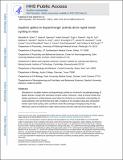Daytime spikes in dopaminergic activity drive rapid mood-cycling in mice
Author(s)
Sidor, M. M.; Spencer, S. M.; Dzirasa, K.; Parekh, P. K.; Tye, Kay; Warden, M. R.; Arey, R. N.; Enwright, J. F.; Jacobsen, J. P. R.; Kumar, S.; Remillard, E. M.; Caron, M. G.; Deisseroth, K.; McClung, C. A.; ... Show more Show less
DownloadTye_Daytime spikes.pdf (972.3Kb)
OPEN_ACCESS_POLICY
Open Access Policy
Creative Commons Attribution-Noncommercial-Share Alike
Terms of use
Metadata
Show full item recordAbstract
Disruptions in circadian rhythms and dopaminergic activity are involved in the pathophysiology of bipolar disorder, though their interaction remains unclear. Moreover, a lack of animal models that display spontaneous cycling between mood states has hindered our mechanistic understanding of mood switching. Here, we find that mice with a mutation in the circadian Clock gene (ClockΔ19) exhibit rapid mood-cycling, with a profound manic-like phenotype emerging during the day following a period of euthymia at night. Mood-cycling coincides with abnormal daytime spikes in ventral tegmental area (VTA) dopaminergic activity, tyrosine hydroxylase (TH) levels and dopamine synthesis. To determine the significance of daytime increases in VTA dopamine activity to manic behaviors, we developed a novel optogenetic stimulation paradigm that produces a sustained increase in dopamine neuronal activity and find that this induces a manic-like behavioral state. Time-dependent dampening of TH activity during the day reverses manic-related behaviors in ClockΔ19 mice. Finally, we show that CLOCK acts as a negative regulator of TH transcription, revealing a novel molecular mechanism underlying cyclic changes in mood-related behavior. Taken together, these studies have identified a mechanistic connection between circadian gene disruption and the precipitation of manic episodes in bipolar disorder.
Date issued
2015-01Department
Massachusetts Institute of Technology. Department of Brain and Cognitive Sciences; Picower Institute for Learning and MemoryJournal
Molecular Psychiatry
Publisher
Nature Publishing Group
Citation
Sidor, M M, S M Spencer, K Dzirasa, P K Parekh, K M Tye, M R Warden, R N Arey, et al. “Daytime Spikes in Dopaminergic Activity Drive Rapid Mood-Cycling in Mice.” Molecular Psychiatry 20, no. 11 (November 2015): 1406–19.
Version: Author's final manuscript
ISSN
1359-4184
1476-5578